Christmas in Crete: Explore Crete During the Festive Season

Christmas in Crete is an exciting event that combines the island’s rich cultural heritage with a festive mood. Crete, located in southern Greece, offers a unique blend of traditions, landscapes and festivals, making it a perfect place for an amazing Christmas vacation.
The Christmas season in Crete is marked by a series of colourful festivals that highlight the island’s long-standing traditions. Local markets come alive with displays of seasonal vegetables, traditional delicacies and handcrafted crafts, providing an excellent opportunity to participate in local culture and obtain unique presents. The towns and villages are decked out in seasonal decorations, such as dazzling lights and elaborately crafted nativity scenes, adding a magical touch to the atmosphere.
The religious aspect of Christmas in Crete is a focal element. The island upholds age-old customs associated with the birth of Jesus Christ because it is mainly Greek Orthodox. Attendees are invited to take in a midnight Mass service on Christmas Eve, where candlelit processions and solemn hymns create a profoundly emotional ambience. The spiritual significance of the season is reflected in the creation and sharing of special delicacies, which frequently include iconic components from the biblical story.
Crete at Christmas has a mild environment that allows for unique outdoor adventures over the holiday season. Visitors enjoy leisurely walks on scenic beaches, historical monuments such as old ruins and Venetian fortresses and breathtaking scenery ranging from harsh mountains to verdant valleys. The combination of the natural wonders and the holiday atmosphere creates an unmistakably magical experience.
Families gather in Greece in December to make and eat a meal that includes traditional dishes such as lamb or pork prepared in various forms, along with a mix of local cheeses, freshly baked bread and delectable desserts such as melomakarona and kourabiedes. Sharing the meals with locals not just provides a taste of traditional Cretan flavours, but allows for valuable cultural exchanges.
When does the Christmas Season in Crete start?
The Christmas season in Crete begins on November 15th and lasts until January 5th, which is Epiphany or Theophany. The season of celebration includes Christmas and New Year’s festivities and it includes the commemoration of the Feast of the Three Kings, making it a significant and pleasant time for the people of Crete.
The festivities last 51 days ending on January 5th. The celebration of the manifestation of Jesus Christ to the world includes the symbolic blessing of waters, which frequently includes the blessing of the sea, rivers and other bodies of water. The holiday is very important in Greek Orthodox tradition and it is celebrated with religious services and celebrations, sometimes accompanied by colourful processions.
The Christmas season in Crete provides an opportunity for families, friends and communities to gather together in a spirit of solidarity and joy. Traditional feasts with local delicacies and celebratory dishes are served. The exchanging of gifts, symbolic of the magi’s offerings to the baby Jesus, is a treasured tradition that delights young and old alike.
What are the Christmas traditions in Crete?
Christmas is a time when Crete’s largely Greek population gathers to observe age-old religious traditions. The midnight Masses on Christmas Eve are at the centre of these traditions. The atmosphere at these services is intensely sombre, with illuminated processions flowing through the streets and melancholy hymns filling the air. The burning of candles symbolises the spiritual significance of the holiday, as the community honours the birth of Jesus Christ. The religious part of Christmas in Crete highlights the island’s deep ties to its faith and history.
The holiday atmosphere pervades Crete’s towns and villages, where streets, squares and buildings are festooned with twinkling lights and beautiful ornaments. The elaborate renditions of the Nativity tale take the stage in the exquisite craftsmanship of Nativity scenes. These scenes serve as reminders of the holiday’s beginnings and give a magical touch to the setting. Christmas in Crete has a special aesthetic beauty due to the combination of traditional decorations with contemporary features.
Cretan cuisine is an essential aspect of Christmas celebrations, emphasising the value of family, sharing and regional flavours. Families gather to create extravagant feasts featuring traditional dishes. The centrepiece of the Christmas table is roasted lamb or pork seasoned with aromatic herbs and spices. These meats are accompanied by freshly baked bread and a range of local cheeses, all of which contribute to the festive feast. The making of desserts such as melomakarona and kourabiedes enhances culinary traditions. These honey-soaked biscuits and almond sugar delicacies are lovingly created and consumed, showing the island’s dedication to preserving its culinary tradition.
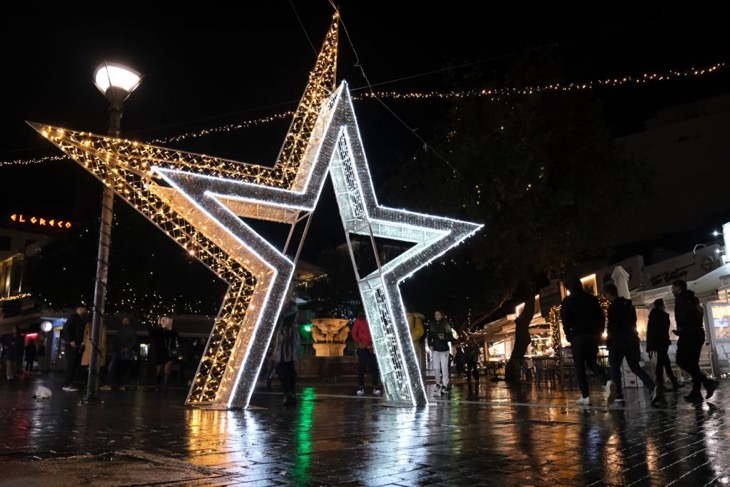
Christmas in Crete develops a strong sense of community and friendship. Local markets and fairs come alive with colourful displays of seasonal produce, artisan items and traditional cuisines. Christmas activities allow both natives and visitors to communicate, engage and participate in the island’s shared customs. Gift-giving and heartfelt exchanges of well-wishes highlight Cretans’ famed generosity and hospitality. The community part of the celebrations pulls people together and produces a welcoming and heartwarming festive environment.
Crete’s warm climate over the Christmas season offers a unique opportunity to appreciate the island’s natural beauties. Visitors are encouraged to explore the outdoors by beautiful beaches, historical attractions and different landscapes. The beauty of Crete compliments the festive spirit, whether walking along the shoreline, seeing ancient ruins or hiking through steep mountains. The union of nature and celebration produces an unforgettable experience that engages both the senses and the soul.
Why Celebrate Christmas in Crete?
Christmas in Crete offers a unique and culturally immersed experience. The island’s blend of traditions, colourful events and welcoming attitude provides a compelling holiday scene. Cretan Christmas celebrations are profoundly anchored in local customs, allowing for participation in generations-old rites.
The attractiveness of celebrating Christmas in Crete arises from the chance to engage in genuine cultural contacts. Residents have kept traditions that demonstrate their deep ties to history and heritage. Participating in traditional carol singing (kalanta) and enjoying local holiday cuisine allows for a significant connection to the island’s culture.
The pleasant winter climate of Crete adds to the allure of a Cretan Christmas. Crete has a temperate climate that allows visitors to explore the island’s sights and participate in outdoor activities without experiencing excessive cold while other European countries experience harsh weather.
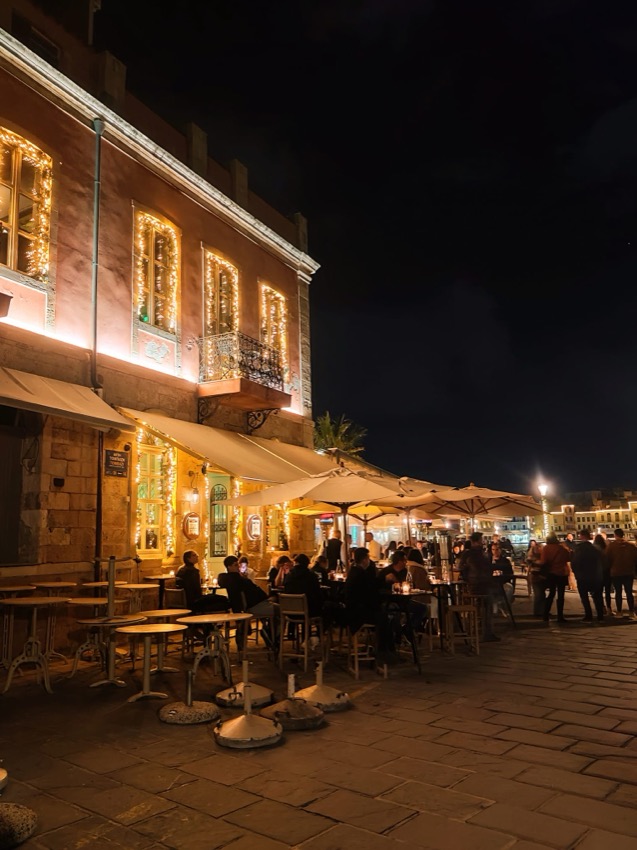
Christmas celebrations in Crete take place in a community setting. The people of the island are known for their friendliness and openness. The island’s Christmas events are characterised by a sense of solidarity and shared delight, whether celebrate with family, friends or local acquaintances.
Christmas in Crete offers an escape from the consumerism that is frequently associated with the holiday season. The focus is instead on heartfelt get-togethers, meaningful rituals and a genuine appreciation of the holiday’s fundamental principles.
How is Crete decorated for Christmas?
Crete combines traditional Greek customs and Western influences in its Christmas decorations. Crete’s cities like Heraklion, Chania,and Rethymnon become festive during the holiday season.
In Heraklion, Plateia Eleftheria serves as the focal point for Christmas celebrations. A grand Christmas tree, surrounded by Santa’s house and kiosks selling traditional decorations and delicacies, stands at the center. The streets are lit with dazzling lights and ornaments.
Chania’s old Venetian port is adorned with hundreds of lights, while a Christmas tree stands near the Egyptian Lighthouse. The lights reflect on the water, creating a mesmerizing view.
A unique Cretan decoration is the presence of small decorated boats, alongside traditional Christmas trees. This custom, rooted in Greece’s maritime tradition, honors St. Nicholas, the patron saint of sailors.
How to say “Merry Christmas” in Crete, Greece?
“Merry Christmas” is expressed in the Greek language as “Καλά Χριστούγεvνα” (Kala Christougenna) in Crete, Greece. The classic Christmas greeting expresses festive wishes for a joyous and fortunate Christmas season.
“Καλά Χριστούγεvνα” (Kala Christougenna) is the usual and generally used method to wish someone a Merry Christmas in Crete and throughout Greece. The remark is strongly embedded in Greek society and is exchanged over the holiday season among family members, friends, neighbours and strangers.
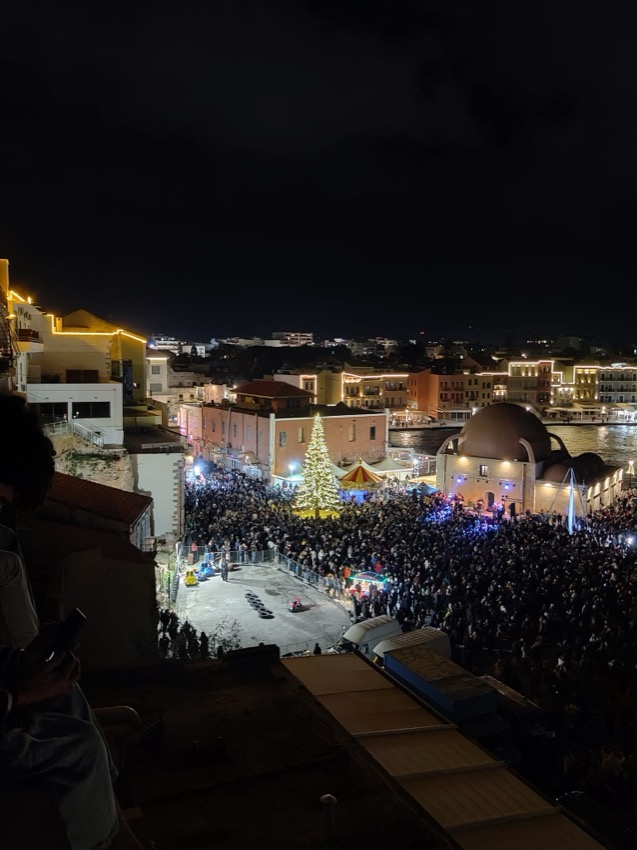
The expression “Καλά Χριστούγεvνα” is a blend of Greek words: “Καλά” (Kala), which translates to “good” or “merry”, and “Χριστούγεννα” (Christougenna), which directly translates to “Christmas”. They produce a warm and emotional greeting that captures the essence of the holiday season when combined.
The statement is more than just a greeting. The statement is a declaration of kindness and well-wishing, encompassing the joy, togetherness and blessings associated with Christmas. “Καλά Χριστούγεvνα” captures the joyful atmosphere and the cultural significance of participating in the festive events when shared with others in Crete and throughout Greece.
How does Crete celebrate Christmas?
Crete celebrates Christmas with religious observances, festive traditions and passionate gatherings that highlight the island’s rich cultural past. The festivities last from December 25th to January 6th and include a range of customs that bring families, communities and tourists together in a joyous and meaningful way.
Christmas is deeply religiously significant in Crete, particularly among the Greek Orthodox community. The season begins on December 25th with the celebration of Christmas Day, which is marked with solemn liturgical services in churches across the island. Common elements of these ceremonies include candlelit processions, religious songs and the telling of the Nativity story through church decorations or nativity sets. Many of the island’s celebrations are based on the religious aspect of Christmas.
Festive decorations fill the streets, public areas and residences throughout Crete. Towns and villages are adorned with twinkling lights, colourful ornaments and carefully sculpted nativity scenes, creating an amazing ambience. Local elements are used in the décor, reflecting the island’s own culture and traditions. The visual shift contributes to the holiday season’s sense of expectation and delight.
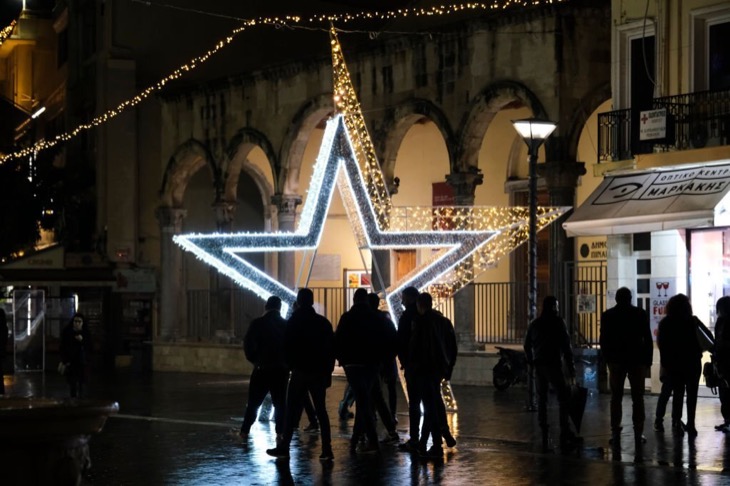
Cretan cuisine takes a front role during the Christmas season. Families gather to cook extravagant feasts with traditional dishes. Aromatic herbs and spices are used to season roasted meats, which are lamb or hog. Everyone enjoys freshly baked bread, local cheeses and a variety of scrumptious desserts such as melomakarona and kourabiedes. The act of sharing such meals symbolises a sense of community and communal joy.
Crete’s Christmas season develops a strong sense of community. Local markets and fairs come alive with seasonal vegetables, homemade crafts and festive cuisine. The gatherings offer an opportunity for both locals and visitors to engage, share stories and experience the island’s hospitality. Christmas season is when neighbours open their doors to one another and the island’s friendly attitude shines brightly.
The Christmas season finishes with the Epiphany feast on January 6th. Religious services are held with the blessing of the waters being one of the most important rituals. Priests throw a cross into the water to be collected by the congregation as they bless the sea or other bodies of water. The symbolic gesture commemorates Jesus Christ’s baptism and reflects the world’s manifestation of divinity.
How people celebrate Christmas in Heraklion?
Heraklion, the largest city in Crete, celebrates Christmas with traditional customs and lively festivities. Eleftherias Square becomes a Christmas Market, with wooden houses offering ornaments, decorations, and treats that create a Santa’s village atmosphere.
The city streets are decorated with lights and adorned with beautifully decorated boats, a unique Greek tradition. Locals and visitors stroll through the market, enjoying festive delicacies like bougatsa and picking gifts for loved ones.
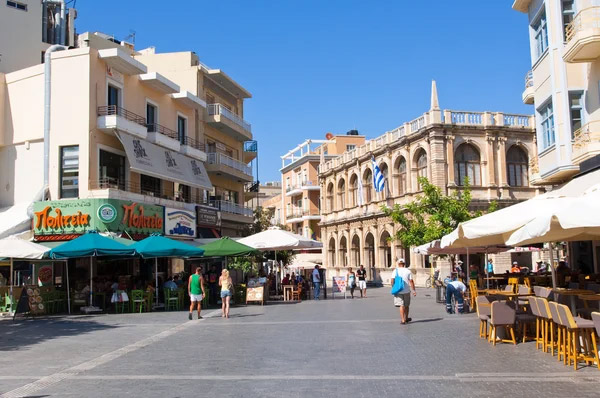
Christmas caroling remains a cherished tradition, with children singing door-to-door on Christmas Eve morning and receiving small gifts or money in return. The Metropolitan Church of Agios Minas hosts special Christmas services, attracting many worshippers.
Throughout December, Heraklion fills with street performances, events, and a festive atmosphere that livens the historical center, creating a joyful experience for both residents and tourists.
What is the Heraklion Christmas Market?
The Heraklion Christmas Market, an annual holiday bazaar in Crete’s capital, Heraklion, brings a magical atmosphere to life with its festive decorations and bright lights. Heraklion Christmas Market attracts both locals and tourists, offering a joyful seasonal celebration. Visitors can explore stalls filled with local crafts, handmade gifts, and delicious traditional Cretan foods, creating an unforgettable holiday experience.
Heraklion Christmas Market is taking place in Eleftherias Square, a central and accessible city location. This site ensures convenience for visitors and access to nearby shops and cafes open during the festive season. The square serves as a hub for holiday celebrations and community gatherings.
Visitors reach the Heraklion Christmas Market via public transport, including well-connected bus routes. Many tourists walk, benefiting from the city’s pedestrian-friendly design. Travelers from other parts of Crete often rent cars for easier access to the market and local attractions.
Popular activities at the Heraklion Christmas Market include browsing stalls offering unique gifts and local delicacies like traditional Cretan pastries and seasonal treats. Live music enhances the festive atmosphere, while carousels and games entertain children. Visitors enjoy tasting local wines and engaging with artisans showcasing their crafts.
How people celebrate Christmas in Chania?
Christmas in Chania brings festive traditions and vibrant celebrations. The old Venetian port is illuminated, with lights reflecting on the water. Streets and shop windows display decorations, featuring boats alongside Christmas trees.
Children enjoy activities like a Christmas carousel, train rides, and ice skating in the town park. On Christmas Eve, children go door-to-door singing carols in exchange for small gifts or treats.
Holiday markets and bazaars offer gifts and traditional sweets like kourampiedes and melomakarona. The aroma of Christmas baking, including Christopsomo, fills the air as families prepare special dishes.
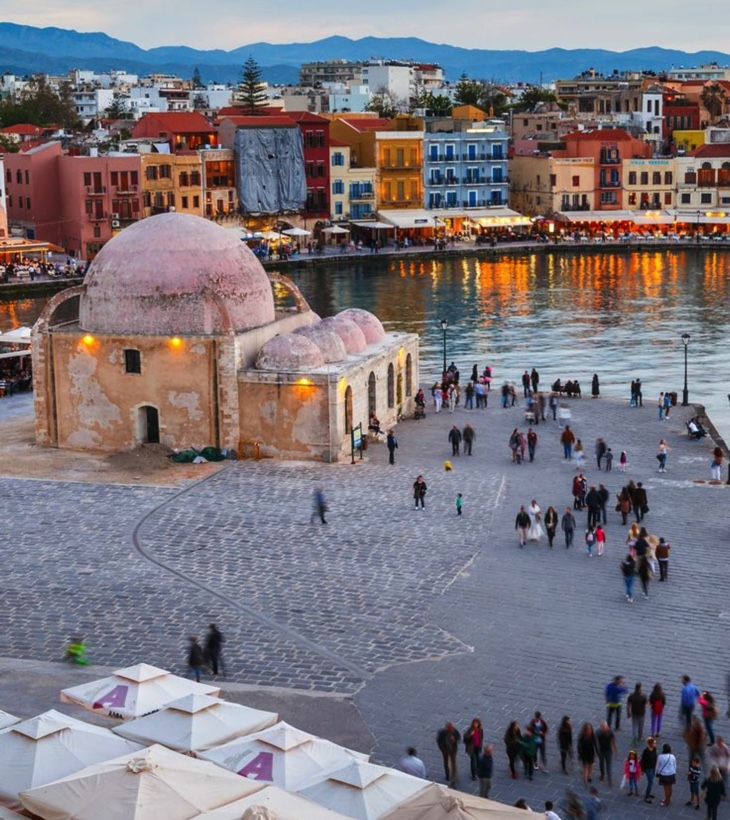
A standout event is the Santa Run on December 26th, where participants dress as Santa Claus and run through the historic center for charity.
What is the Chania Christmas Market?
The Chania Christmas Market is a festive event in Chania, Crete, showcasing holiday-themed stalls with local crafts, decorations and traditional Cretan food. It is located in the historic old town and features illuminated streets, live music, and seasonal cheer, creating a vibrant holiday atmosphere.
The Chania Christmas Market, located centrally in Chania’s old town, is accessible on foot for nearby visitors and connected to other towns in Crete via public transportation, with bus services complementing car rentals available at Heraklion and Chania airports.
The market features activities for all ages, including live performances by local musicians and dancers, workshops for children to create holiday crafts, and food stalls offering traditional Cretan delicacies such as roasted chestnuts, honey pastries, and mulled wine.
Special events like Santa Claus visits and festive parades further enhance the celebratory atmosphere. Chania Christmas Market is a family-friendly market which brings parents and children together for memorable experiences, where parents shop for unique gifts while children immerse themselves in holiday activities.
What is Santa Run in Chania?
The Santa Run in Chania is an annual charity event held in late December, usually on December 26th . Santa Run started in 2011 and has grown into one of Greece’s largest charity fundraisers. Participants, dressed as Santa Claus, walk a 3.5-kilometer (2.2 miles) route through Chania’s old town and harbor. A free Santa costume and a sack for gifts are provided to all participants.
The event is volunteer-run, involving the whole community, with local businesses offering treats and DJs playing music across the city. Beyond the walk, activities like face painting, live music, and parties engage participants. Local charities helping children with health challenges, such as ELEPAP, K.H.F.A.AMEA, KIFAP “Megalohari”, and Horizon, benefit from all proceeds.
The Santa Run raised over 420,000 € ($452,000, £366,000), in its first eight years. Chania Santa Run has become a key feature of Chania’s Christmas celebrations, drawing both locals and tourists to support vital causes.
What is the weather in Crete during Christmas?
The weather in Crete during Christmas is mild and pleasant. The island has a Mediterranean climate, which means that winters are milder than in many other parts of Europe. The Crete weather in December is cool but not freezing, creating a suitable atmosphere for holiday gatherings and outdoor activities.
The average temperature in Crete throughout December, including the Christmas season, ranges from roughly 10°C and 16°C (50°F and 60°F). The temperatures achieve a compromise between producing a lovely environment for holiday activities and providing a refreshing chill in the air. The moderating influence of the water frequently results in slightly lower temperatures in coastal places, such as the magnificent beaches that define Crete’s landscape. The maritime influence leads to a mild temperature that is especially appealing for people looking for a Christmas vacation.
The wind on the island differs especially along the coast. They are not too strong during the Christmas season. There are days with slightly heavier breezes, but they are unlikely to interfere with outdoor activities or lessen the festive mood. The result is that locals and visitors enjoy the festive atmosphere without being concerned about inclement weather.
The warm weather in Crete over the holidays invites visitors to participate in a variety of holiday activities. Locals and visitors enjoy outdoor markets, historic sites, leisurely walks along the beach and social events without needing to wear heavy winter clothing. The pleasant weather helps to the Christmas season’s sense of joy and togetherness, establishing an environment in which festive decorations, traditional cuisine and friendly exchanges flourish.
What to wear in Crete during Christmas?
Layers and clothing appropriate for mild weather are recommended for Christmas in Crete. A light sweater or long-sleeved shirt coupled with slacks or jeans is a typical ensemble. Comfortable walking shoes and a light jacket or coat for cooler evenings are recommended. The weather is mild and it is wise to be prepared for temperature fluctuations.
The moderate Mediterranean temperature of the island must be considered while deciding what to dress in Crete for Christmas. Temperatures in the range of 10°C and 16°C (50°F and 60°F) offer a comfortable setting that allows for a variety of outdoor activities and celebratory gatherings.
A practical outfit consists of a light sweater or a long-sleeved shirt as a base layer. A light outfit provides warmth without being too heavy, allowing for easy layering if the temperature changes throughout the day. Pairing it with pants or jeans ensures both comfort and versatility, making it suitable for walking around towns, exploring historical sites and enjoying leisurely strolls on the beach.
Wear comfortable footwear because exploring Crete includes walking on different terrains. Choose sturdy shoes or sneakers that give support and are appropriate for a variety of activities. Having a light jacket or coat on hand helps maintain warmth during outdoor evening events or dinners as the sun sets and the temperature lowers a little.
Slight temperature differences occur depending on the exact island location. Coastal places have milder circumstances due to the sea’s moderating influence, whereas interior areas or higher elevations experience cooler conditions. Wearing layered clothing helps in adjusting to changing weather and activities.
What are the Christmas activities and traditions in Crete?
Listed below are the Christmas activities and traditions in Crete.
- Christmas Ships: A unique tradition known as “Karavaki” or Christmas Ships takes place in numerous coastal towns and villages around Crete. Miniature boats and ships are paraded through the streets before being launched into the water, decked with festive lights and decorations. The tradition represents the island’s seafaring background and provides a unique flavour to the Christmas celebrations.
- Nativity Plays: Nativity plays, commonly referred to as “Bethlehem” or “Christopsomo” in Greek, are a significant component of Crete’s Christmas festivities. Nativity Plays depict the Nativity story, including Jesus Christ’s birth, the trip of the Three Wise Men and other associated events. The concerts are organised by local schools, churches and community groups.
- Christmas Kalanta (Carols): Carolling at Christmas or “Kalanta”, is a beloved ritual in Crete and throughout Greece. Children and adults in groups travel door-to-door singing traditional carols and wishing blessings on families. The tradition is a heartfelt way to spread holiday cheer and connect with neighbours and friends. Residents frequently offer sweets or small gifts to the carolers in exchange.
- Nativity Fast: The Nativity Fast, which is referred to as “Filokalia” or Advent, is a fasting and spiritual preparation time preceding Christmas. Nativity Fast starts on November 15th and ends on December 24th. Many Cretans observe dietary restrictions during the Christmas season, abstaining from specific foods and practising meditating on the significance of the Christmas season and developing their religion.

1. Christmas Ships
The display of Christmas Ships, commonly known as “Karavaki”, is one of the unique and captivating traditions that decorate the Christmas season in Crete. The tradition is transforming miniature boats and ships into floating works of art decorated with bright lights and festive decorations. The tradition pays homage to the island’s deep-rooted maritime past, resulting in a really unique aspect of the Christmas celebrations.
The Christmas Ships custom makes full use of the island’s personal connection with the sea, nestled along the coasts of numerous cities and villages across Crete. The little Christmas Ships decked with lights and ornaments glide gently across the waters, throwing a wonderful glow over the calm sea. The scale and location of these displays vary, from small villages to larger towns, ensuring that both residents and visitors enjoy the captivating sight.
The Christmas Ships celebrations begin in the early evening when the sun begins to set below the horizon. The specific start time varies by location, but the allure of the tradition is universal. The image of the illuminated boats reflected in the sea against the backdrop of the night sky is captivating. The celebrations last far into the night, allowing guests to fully immerse themselves in the enchanting environment created by the floating works of art.
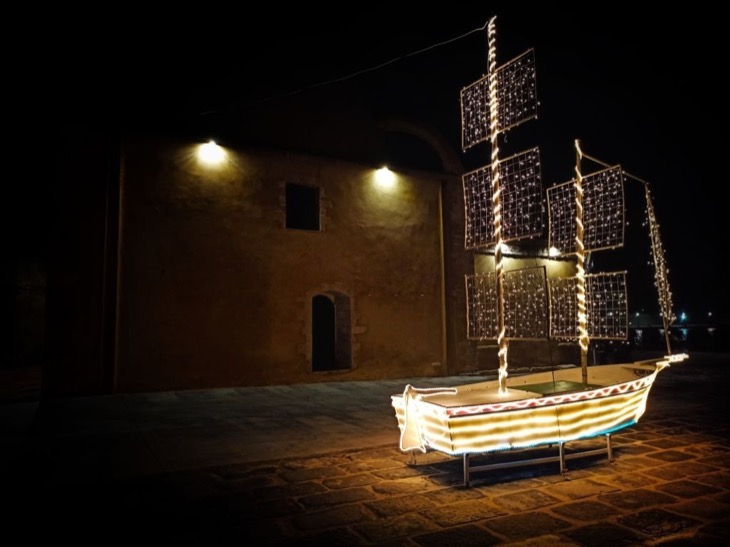
The accessibility of the Christmas Ships tradition is one of its most appealing features. There is no official admittance fee to take in the amazing exhibition majority of the time. Communities and local groups frequently take satisfaction in sponsoring the event, which provides an inclusive and welcoming environment for anyone to participate in. Attendees congregate along the shoreline or at designated viewing spots to gaze at the lit vessels as they set sail.
The illuminated boats are unquestionably the main attraction of the Christmas Ships tradition, although certain places add other decorations to heighten the holiday atmosphere. It includes local entertainment such as live music shows and food stands selling regional specialties. These elements enhance the festive spirit and transform the occasion into a social celebration that invites people together to partake in the season’s delight.
2. Nativity Plays
The Nativity play mimics the Nativity tale, bringing to life Jesus Christ’s birth, the journey of the Three Wise Men and other significant episodes from the biblical account. The tradition serves as a reminder of the true meaning of Christmas and has great spiritual resonance for both participants and viewers.
Nativity Plays are organised by churches, schools and community groups. These lectures are held in churches, outdoor settings or dedicated communal places. The site differs from village to village or town to village or town, guaranteeing that locals and visitors from all around Crete participate in the tradition.
Nativity plays are staged during the Christmas season, often in the weeks preceding Christmas Day. The exact start and end times depend on the organisers and the location. Nativity plays begin in the early evening, giving audiences time to assemble and immerse themselves in the story unfolding in front of them. A Nativity Play lasts one to two hours and includes many scenes that capture the core of the Nativity narrative.
Nativity Plays do not charge an admission fee. Nativity Plays are provided as a community service, allowing individuals and families to gather and enjoy the show without financial restraints. Attendees are urged to enjoy the event’s ethos, which is centred on sharing and reflection.
The benefits of a Nativity Play experience go beyond the act itself. Nativity plays frequently encourage an audience’s sense of togetherness and connection in addition to retelling the biblical account. The environment is reverent and communal, allowing people to congregate, ponder and celebrate the actual meaning of Christmas. The shared experience of witnessing the Nativity story live contributes to a sense of connection and shared spirituality.
3. Christmas Kalanta (Carols)
The singing of Christmas Kalanta is a treasured tradition that resonates with the cheerful atmosphere of Christmas in Crete. The musical expressions of joy and kindness are sung by groups of youngsters and occasionally adults as they go door-to-door, sharing festive tunes and well-wishes with their neighbours and friends. Christmas Kalanta represents friendship, kindness and the festive season.
Christmas Kalanta is practised throughout Crete, particularly in neighbourhoods and small settlements. Carolers make their way through the streets, stopping at homes, shops and public places to spread the cheerful sounds of the season. The practise fosters connections among neighbours and enhances the sense of unity by creating an open and festive atmosphere.
The singing of Christmas Kalanta begins in the weeks leading up to Christmas, often beginning after dusk and continuing until late into the night. The particular start and end hours depend on the locale and the carolers’ schedules. The wonderful glow of holiday lights gives an appealing backdrop to the carolers’ performances as the sun sets and darkness falls, boosting the festive ambience.
The length of a Christmas Kalanta session is dependent on the number of stops and the carolers’ and recipients’ excitement. Groups stop at each spot for a few minutes to share their harmonising tunes and festive enthusiasm. It gives the carolers time to interact with the residents, resulting in a pleasant dialogue that epitomises the spirit of giving and generosity.
4. Nativity Fast
The Nativity Fast is a period of spiritual preparation leading up to Christmas in Crete. The tradition includes a period of fasting, reflection and self-discipline as individuals and communities prepare to honour the birth of Jesus Christ. The Nativity Fast emphasises spiritual growth, self-awareness and dedication.
The Nativity Fast is observed by Cretans at their local churches and homes, with families and individuals participating as a part of their faith. The Nativity Fast is an Orthodox Christian concept that encourages people to abstain from specific meals and behaviours in to focus on their spiritual path and the forthcoming celebration of Christ’s birth.
The Nativity Fast begins on November 15th, marking the official start of the period of preparation leading up to Christmas Day. The fasting period lasts forty days, ending on December 24th, which is Christmas Eve. Participants abstain from eating meat, dairy products and occasionally even fish for forty days. The emphasis is shifting towards plant-based foods, grains, legumes, fruits and vegetables.
There is no formal admission fee to observe the Nativity Fast, unlike some other traditions. Individuals and families choose to join in the spiritual practise as an expression of their faith and dedication. The Nativity Fast is seen as a self-disciplined and self-awareness offering, allowing people to draw closer to their spiritual centre as they prepare to commemorate Jesus Christ’s birth.
The Nativity Fast offers participants a one-of-a-kind chance for introspection, prayer and thought. Individuals seek to nurture virtues of humility, compassion and gratitude by abstaining from particular foods and performing acts of charity. The Nativity Fast promotes a stronger connection with one’s faith and a greater understanding of the spiritual meaning of Christmas.
What kind of meat is usually served during Christmas in Crete?
Traditional Christmas meats in Crete are lamb or pork. Lamb and pork meats have special cultural and culinary value since they represent the island’s history, religious practices and festive rituals.
Lamb and pork are popular Christmas foods in Crete, as they are in many other places in Greece. These meats are not just wonderful culinary options, but they have cultural and religious significance that is deeply embedded in the island’s traditions.
Lamb is a particularly noteworthy meat choice due to its relationship with religious symbolism. Jesus Christ is referred to as the “Lamb of God” in Christianity and the lamb is frequently served at religious feasts and other occasions. The association between lamb and religious practise is popular in Crete. The devout Orthodox Christian population of the island regards the lamb as a sign of sacrifice and redemption, linking it to the spiritual parts of the Christmas celebration.
Pork is used to make a range of traditional meals that highlight the island’s culinary heritage. Many Christmas dinners feature roasted pigs seasoned with aromatic herbs and spices. Roasted pork’s flavorful and succulent character makes it a popular option for special events and its appearance on the Christmas table adds to the festive ambience.
Lamb and pork are served following age-old family recipes passed down through generations. These foods evoke nostalgia and tradition, bridging the gap between the past and the present. The act of cooking and sharing these meats fosters a sense of community as families meet to share celebratory dinners.
What are the Christmas treats to eat in Crete?
Melomakarona and kourabiedes are two popular Christmas specialities in Crete. These traditional sweets are part of the island’s festive culinary offerings, captivating locals and visitors alike with their distinct flavours and textures.
Melomakarona and kourabiedes are traditional Cretan Christmas delicacies with a special place in Cretans’ hearts and palates. Melomakarona and kourabiedes are made with love and care, capturing the spirit of the festive season and reflecting the island’s culinary heritage.
Melomakarona is a honey-soaked cookie created from a dough that contains flour, olive oil, honey, cinnamon and orange zest. The cookies are dipped in a syrup composed of honey, sugar and water after baking until they are a golden colour, allowing them to soak up the sweet and aromatic flavours. Crushed walnuts are commonly sprinkled on completed melomakarona, imparting a delicious crunch to their soft texture. These delectable delights are not just a feast for the taste buds, but a testament to the abundance of Cretan ingredients and flavours.

Kourabiedes are delicate almond shortbread cookies dusted with powdered sugar to give them a snowy appearance typical of the winter season. Butter, almonds, powdered sugar and a dash of brandy or rose water for flavour are the main ingredients. The cookies are baked until just soft, then sprinkled liberally with powdered sugar while still warm. The end product is a crumbly dessert that is elegant and decadent.
Melomakarona and kourabiedes are popular Christmas treats in households and bakeries throughout Crete. Families gather to share these goodies, which are accompanied by hot beverages such as tea or coffee. The act of gifting and sharing these sweets emphasises the feeling of togetherness and hospitality that characterises the island’s Christmas season.
Cretan sweets have withstood the test of time, preserving Crete’s culinary heritage and bringing joy to generations of Cretans. The Christmas season’s cooking fragrances of honey, cinnamon, almonds and orange zest create nostalgia and warmth, producing a blend of senses that compliments the island’s festive decorations and celebrations.
What are the tourist conditions in Crete in December?
Crete in December provides a unique experience for tourists seeking a different view of the island. December brings mild weather, with average daytime temperatures between 10°C to 16°C (between 50°F to 60°F). Though the month is wet, frequent sunshine and clear skies break up the rain. The cooler climate is ideal for exploring archaeological sites and hiking through Crete’s landscapes.
A key advantage of visiting in December is the lack of crowds. Visitors can explore attractions like Knossos Palace peacefully, often with reduced entrance fees. The absence of summer tourists allows for a more authentic experience of Cretan culture and traditions.
Christmas adds a festive atmosphere to Crete’s cities. Heraklion’s Christmas market at Plateia Eleftheria features local food, handmade crafts, and decorations. Chania’s old Venetian port is illuminated, creating a magical ambiance.
Although some tourist facilities close, many local restaurants and tavernas remain open, offering authentic Cretan cuisine. December in Crete offers a quieter, more intimate experience of the island’s culture and beauty.
Can you swim in Crete in December?
Yes, you can swim in Crete in December. Crete has a mild Mediterranean climate, which means that the water is a bit cold for other people but is still fine for those who are used to cooler water. The sea temperature averages approximately 17-20°C (63-68 °F), providing a nice dip for those who want to go in.
The setting of December as Crete’s winter season adds complexities to the experience. The air is tolerable throughout the day, but nights and evenings are noticeably colder. The risk of severe weather, including rain and gusts, influences the decision to swim and has an impact on comfort and safety.
Choosing well-kept beaches with features such as changing areas improve the experience if one decides to go swimming in Crete in December. Monitor weather forecasts and water conditions before beginning a swim, prioritising safety considerations.
Is Crete, Greece, worth visiting during Christmas?
Yes, Crete, Greece, is worth visiting during Christmas due to its unique blend of festive traditions, mild weather and cultural charm. Visiting Crete during the Christmas season is a wonderful experience that provides a unique perspective on the holiday season. There are reasons why Crete is an interesting visit at Christmas time.
Christmas traditions in Crete are strongly ingrained in its cultural past. The island has a variety of distinct customs, from the mesmerising Christmas Ship parades to Nativity Plays that bring the biblical account to life. Visitors immerse themselves in the island’s rich history and dynamic community spirit by taking part in these local customs, making memories that transcend beyond the usual holiday celebrations.
Crete experiences a warm Mediterranean climate in the winter, in contrast to many other places in Europe. The temperature remains pleasant, allowing visitors to enjoy the island’s gorgeous landscapes, quaint villages and historical attractions without being restricted by harsh winter weather. The pleasant environment enriches the experience by allowing for outdoor activities, leisurely walks and participation in local events without the coldness of colder places.
Christmas in Crete allows visitors to connect with the local culture on a more personal level. Traditional holiday sweets such as melomakarona and kourabiedes allow visitors to savour the flavours of the island, while the Nativity Fast demonstrates the island’s religious commitment. Participating in the singing of Christmas Kalanta carols with the residents fosters a sense of friendship and shared celebration, establishing connections that enrich the vacation experience.
The natural beauty of the island, with its gorgeous shoreline, rocky mountains and picturesque settlements, is just as intriguing in the winter. Exploring Crete off the beaten path allows visitors to appreciate the tranquillity and authenticity of the surroundings without being surrounded by the bustling throngs that are common during peak tourist season.
The locals prepare for Christmas festivities. The air is filled with excitement and anticipation as residents decorate the streets with colorful lights and adorn their homes with wreaths and ornaments. Crete at Christmas was a magical time, where the island’s rich culture and warm hospitality truly shone.
How to get to Crete at Christmas?
Secure flights to major airports such as Heraklion International Airport or Chania International Airport for individuals arriving from abroad. The entrance points provide direct access to the island, ensuring efficient transit. Immerse in Crete’s festive atmosphere and join the Christmas celebrations upon arrival.
Ferry services connect Crete with mainland Greece for an immersive experience. Depart from ports such as Piraeus in Athens for a picturesque nautical excursion that offers a unique perspective of the Mediterranean. Choose from a variety of ports in Crete, including Heraklion, Chania, Ag. Nikolas, Rethymno, Sitia and Kastelli-Kissamou depending on the destination.
Crete’s vast terrain demands transportation, with land-based options accessible for anyone wishing to travel the island. Taxis and buses are convenient modes of public transportation, while taxi costs skyrocket. Renting an automobile appears as a viable option, offering flexibility and autonomy. Keep in mind that the rocky nature of Crete’s roads suit more experienced drivers. Car rental fees start around EUR 100 for a 7-day rental period, rendering it a feasible and appealing option for those planning on how to get to Crete.
What are the best places to rent a car in Crete during Christmas?
The rental companies have branches at major airports such as Heraklion International Airport and Chania International Airport. The strategic positioning guarantees that the rental car is ready upon arrival. Rental offices are found in prominent tourist destinations and city centres, ensuring accessibility and adaptability for transportation needs throughout the holiday season.
Cars are available for rent from several established car rental agencies situated across the island during Christmas in Crete. Recognizable companies such as Hertz, Avis, Europcar and Budget, along with local providers such as Justrentals and Rental Center Crete offer their services to cater to the requirements of travellers.
Choosing to rent a car allows visitors to explore Crete’s festive sites and festivities at their own pace. Having a rental car improves the experience overall whether exploring Christmas markets, taking part in traditional events or appreciating the island’s scenery decorated for the season. The availability of rental cars during Christmas ensures smooth navigation around the island’s numerous areas and permits participation in various seasonal celebrations. Choosing to rent a car in Crete provides the freedom to plan a festive itinerary and explore Crete’s holiday offerings according to individual preferences.
How is Parking in Crete at Christmas?
Parking in Crete over the holidays is a simple and manageable task. The Christmas season’s unusual timing leads to a smaller influx of tourists compared to the busy summer months, resulting in a noticeable reduction in parking issues. The lower demand for parking places translates into a more comfortable and stress-free experience for those who choose to visit Crete during the holiday season.
The island’s lovely towns and picturesque villages, which are often packed with visitors during the summer, usually have plenty of parking available during the holidays. The entire mood is noticeably more laid-back, even though popular spots require a certain amount of planning. Urban areas with parking issues during peak hours, such as Heraklion, Chania and Rethymno, offer a comparatively easy parking process in December.
Parking becomes even more convenient throughout the holiday season for tourists lured to Crete’s picturesque coasts and magnificent vistas. The most popular beach spots and lookout points, which require strategic parking choices during the summer, frequently have an abundance of open parking places. The advantageous parking scenario complements the island’s quiet winter ambience, inviting tourists to slowly explore these places without the normal parking difficulties.
It is easy to find parking in Crete over the holidays, but it is a good idea to prepare for a few potential problems. Arriving a little sooner to local festivals or events, particularly in towns and villages, ensures to acquire a parking spot close by. Relying on public parking lots or designated parking zones helps to avoid any hassle when touring places with restricted parking options, such as densely constructed city centres.
How much does Car Rental in Crete cost at Christmas?
Local car rental Crete companies like Rental Center Crete charges are between €30 and €40 per day for rental vehicles, offering a diverse fleet of cars to suit various preferences and needs. Those planning a week-long trip during Christmas can expect an average cost of €250 for renting a car in Crete, while a weekend trip during Christmas time might cost approximately €78 on average. Keep in mind that the price ranges are estimates and subject to change based on seasonal demand, vehicle type, added services, insurance coverage and any active specials.
Automobile rental rates tend to be steady over the Christmas season compared to the busiest summer months when there is just mild tourist traffic. Booking a rental car ahead of time is recommended to assure favourable rates and availability.
It is best to directly contact respectable automobile rental firms or use trustworthy web platforms for accurate and up-to-date price information. Comparing pricing quotes, examining reviews from prior customers and gaining a thorough understanding of the rental terms help to make an informed decision that fits the budget and travel goals for the Christmas trip to Crete.
Do Car Rental prices in Crete increase during the Christmas season?
No, car rental prices in Crete do not increase during the Christmas season. The need for rental automobiles tends to be less intense during the winter holiday season than it is during the busiest travel seasons, which often fall during the warmer months. The increased holiday travel activity causes small pricing changes, but it is unusual for the Christmas season to bring about significant price increases for car rentals.
The fact that fewer people travel to Crete overall during the holiday season than during the busy summer months is one of the main factors contributing to the consistent cost. Renting a car is, therefore, less competitive, yet demand is manageable. The island becomes overrun with tourists throughout the summer season, resulting in greater demand and, as a result, higher rates for a range of services, including automobile rentals.
The lack of considerable price rises during the Christmas season is beneficial for travellers who want to explore Crete with the comfort and flexibility of a rental car without incurring significant cost increases. Cheap car rental prices allow guests to make the most of their vacation experience by exploring the island’s cultural attractions, scenic places and local festivities.
Is a Driving Licence required to rent a car in Crete at Christmas?
Yes, a driving licence is required for renting a car in Crete. Driving licence requirement derives from legal laws and practical concerns, ensuring safe and responsible driving for all parties involved.
Driving a motor vehicle without a valid licence is illegal in Crete, following global regulations. Car rental companies are required to uphold these regulatory requirements by guaranteeing that their rental vehicles are just operated by people who have the necessary certifications. The request for a valid driving licence acts as proof that the driver meets the legal requirements for traversing the region’s roadways.
A driving licence is important for insurance considerations in addition to legal duties. Car rental companies demand proof that drivers are eligible and insured in the event of an accident. The driver’s licence serves as proof of the driver’s ability and legitimacy to operate a vehicle. The confirmation is required to fulfil the duties associated with driving a rented car.
The driver’s licence serves as an identification, confirming the driver’s status as the authorised operator of the rental vehicle. The validation helps rental firms to confirm the driver’s identification with the reservation details, guaranteeing that the intended driver is driving the vehicle. The function of the driving licence as a verification instrument improves the security measures and operational openness of rental firms.
Carrying an International Driving Permit is useful for driving licences that are not issued in English or Greek. International Driving Permit serves as a multilingual translation of the driver’s licence. The document not just facilitates communication with local authorities and rental facilities but enhances the rental experience by providing an extra layer of simplicity and clarity for those wondering if a driver’s licence is required to rent a car in Crete.
Is renting a Car better than hiring Taxis or Transfers Services in Crete?
Yes, renting a car is better than hiring taxis or transfer services in Crete. Renting a car gives unequalled flexibility. Travellers create their own itineraries, choosing destinations and timelines without being constrained by predetermined schedules. The independence is beneficial during the busy Christmas season, allowing for full participation in local festivities, event attendance and thorough exploration of the island’s scenic attractiveness.
Using taxis or transfer services results in long wait times and coordination difficulties. Choosing to hire a car eliminates such delays, allowing direct access to preferred areas, particularly if demand for transportation is high due to holiday activities.
A hired car allows access to isolated and less-travelled areas that taxis are not capable to reach. Crete’s allure extends beyond its main centres, to include tranquil countryside, picturesque villages and enchanting seaside retreats. Having a car leads to the easier discovery of these hidden wonders, enhancing one’s involvement with the island’s natural beauty.
Renting a car turns out to be cost-effective in terms of finances, particularly for families or groups. The convenience of having a dedicated vehicle for the duration of the trip balances the costs of frequent taxi rides or transfer service fees.
The element of surprise is an added bonus. There is no need for pre-arranged transportation, so encountering a picturesque village, an unanticipated Christmas market or an unexpected vantage point is met with seamless enjoyment.
The rental car becomes useful for transporting bags and gifts, ensuring their safe transportation throughout the excursion. Rental cars facilitate a more in-depth engagement in Cretan culture by allowing trips to traditional markets, authentic cuisine and full participation in Christmas traditions. The option presents an alternative to relying solely on taxis or transfer services in Crete, granting the freedom to explore and fully immerse in the festive atmosphere.
Last updated on January 5th, 2025














